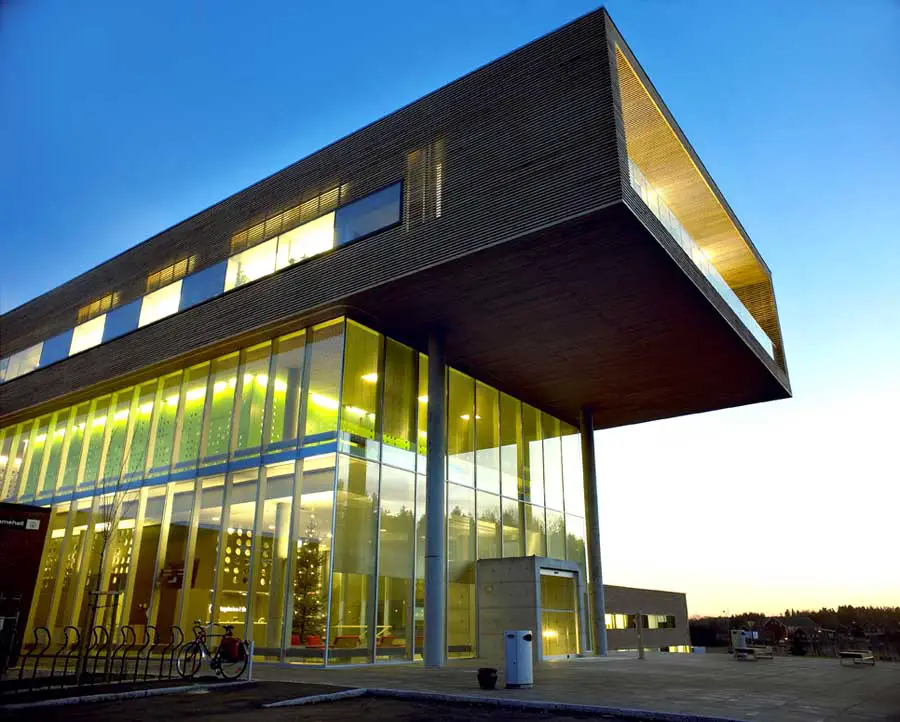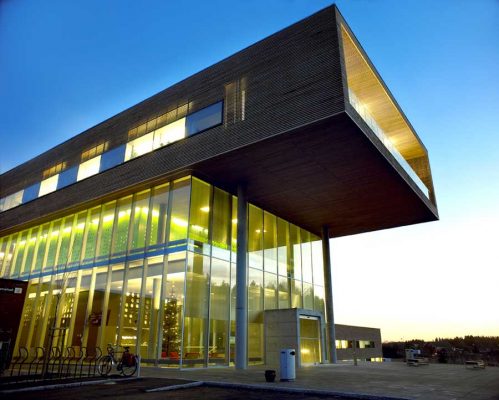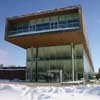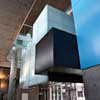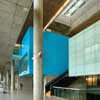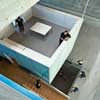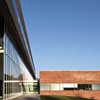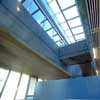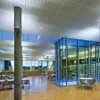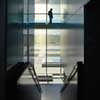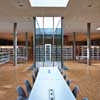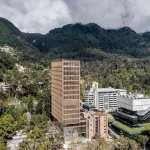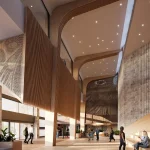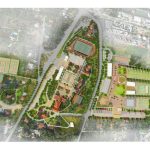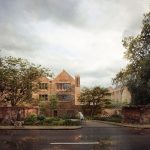University College Østfold, Norway Education Building, Project Photos, Design News, Images
University College Østfold Norway
Norwegian Higher Education Development design by Reiulf Ramstad Architects
1 Jun 2009
University College Østfold
Location: HiØ, Halden, Norway
Architects: Reiulf Ramstad Architects
Nominated for the prestigious Mies van der Rohe Prize when completed 2006
Concept
The HiØ is compact building shaped like a treasury cabinet of knowledge and science covered in wood, glass and concrete. The concept is based on four principles:
1. landmark significance
2. symbolic power
3. energy efficiency
4. flexibility/elasticity
1. Landmark significance
HiØ is located in the outskirts of the city of Halden in the transition zone between urban and rural landscape. To emphasize the importance of the relation between landscape and building the HiØ is visible from the city and its surroundings and the cultural and historical landscape should be visible from the campus.
The elevation of the building constitutes an essential part of the project, where symbol and function merge into one. A landmark that relates to and incorporate the natural and cultural environment offered at the estate, such as the cultivated park, an old forest and the nearby farms.
2. Symbolic power
Globalization and technologic development change the essence of knowledge and science. The HiØ incorporates both the ideas of an architectural projection of the modern Norwegian state and the symbolic significance of an European cultural heritage. It must be regarded as a power station for developing future academic generations of the region.
HiØ has a strong modern identity with a spatial solution that differs from a conventional university building, and in that way making a monument of a new era where sustainability, energy efficiency and environment concerns are the main values.
3. Energy efficiency
The building represents an energy efficient construction with sustainable use of space and materials. This compact building mass contributes to:
Moderate building costs – minimized technical installations
Reasonable low operating costs
Efficient distribution for ventilation, electro technical installations, heating system and communication
Moderate heating and cooling demands that requires totally a low energy demand
4. Flexibility/elasticity
The program is molded into a simple architectural structure. The building has a simple dense carpet like form and rational constructive solutions to obtain elasticity that permits many ways of organizing circulation, zones and activities.
The building
The key notion of the architectural strategy is the location’s natural features and the use of a limited material palette. The project is situated in an old rural landscape and special attention is paid to integrate it into its surroundings. The design is based on simple geometrical prisms, lines and slabs composed into a complex lay-out of rooms and functions.
Critical functions and lines of communication are emphasized and the building expresses a balance of functional efficiency and open perspectives.
Completed in 2006 the HiØ is a building of national and regional importance. Situated between Oslo and Sweden this University building is a melting pot for many cultures and people.
This mixture is also reflected in the complex intertwine of new and old buildings. The challenge was to refurbish the existing complex, originally completed in the 70s, modernizing it to suit the College’s current, and future, needs whilst adding to it new functions and spaces that would complement the existing.
From early in the competition stages RRA approached this project creating a landscape and cityscape strategy. The project was developed as more than a response to the program, new functions and spaces where ingeniously designed into the buildings, expanding the dimension of the project beyond that of mere architecture.
More than 900 rooms are organized around common spaces, small “forums” or “agoras”, reminders of what a University Life is all about. Informal meeting spaces, debating arenas, and areas of personal exploration punctuate all the buildings.
Hovering over all the other buildings, tracing the east-west natural ridge between two forests, is a long wood-clad volume which houses the new study rooms and office spaces. This structure, which could almost be seen as an independent building is in reality the articulating element, the spine, of the whole complex.
New and old meet here, intimate spaces for reflection appear and monumental rooms are presented, common boundaries are challenged and the relationship between in and out gets blurred.
Where this block intersects the new Library, it opens up in a series of dynamic spaces. Boxes hang from the ceiling defying the laws of physics, light pours in from sky lights and from the continuous glazed façade inviting one out onto the Library’s roof terrace.
The Roof of the Library is the main exterior meeting space, a main square, a plaza, for the Campus, an extension of the College’s functions to the landscape, a clear reference to the preoccupations that RRA has in dealing with the existing context, buildings (city) and landscape.
The careful choice of materials enhances the experience of this building. Concrete and glass are counterbalanced with colour and softer/warmer materials, such as wood and brick. They blend new and old together creating a unique feeling of accord and defiance, an ideal environment for learning and personal development.
The double and triple height spaces created through the main buildings are changed, their volumes sculpted, shaped by the changing light conditions during the dramatically diverse Norwegian seasons. In the Summer this a building to be lived outside, the various courts filled with students and open to the landscape, in the Winter the generous use of glass allows for the landscape to be enjoyed from the inside. The large Foyer space replaces the roof terrace and the building is filled with discussions and debate.
The glazed façade and multiple openings are not however a detriment to the buildings energy efficiency. In fact they reduce the need for artificial light by bringing light deep into the complex. Further more by the use of mass and a structured planning strategy the building is able to keep its internal temperature fairly constant all year long with limited heating/cooling costs for a building of its size.
Most of the fittings and furniture was designed by RRA and this has added to the general harmony of the complex.
University College Østfold – Building Information
Title: UNIVERSITY COLLEGE ØSTFOLD HALDEN (HiØ)
Architects: Reiulf Ramstad Architects (RRA), Oslo, Norway
Location: Halden, Norway
Program: University College
Size building : 28,000 sqm
Size site: approximately 200.000 m2
Commission type: Invited Competition 1st prize
Construction year: 2004-06
Client: Norwegian Public Construction and Property Management
Photographs: Reiulf Ramstad Architects and Kim Müller, Norway
Location: Halden, Norway
Norwegian Architecture
Contemporary Norwegian Architecture
Norwegian Architecture Designs – chronological list
Oslo Architecture Walking Tours
Østfoldmuseet : RRA
Norwegian Architecture – Selection
DnB NOR Headquarters Building, Bjørvika waterfront, Oslo
MVRDV
DnB NOR Headquarters
Østfold Hospital
AART / Arkitema / Eliassen and Lambertz-Nilssen Arkitekter
Østfold Hospital
Comments / photos for the University College Østfold Norway Architecture page welcome

